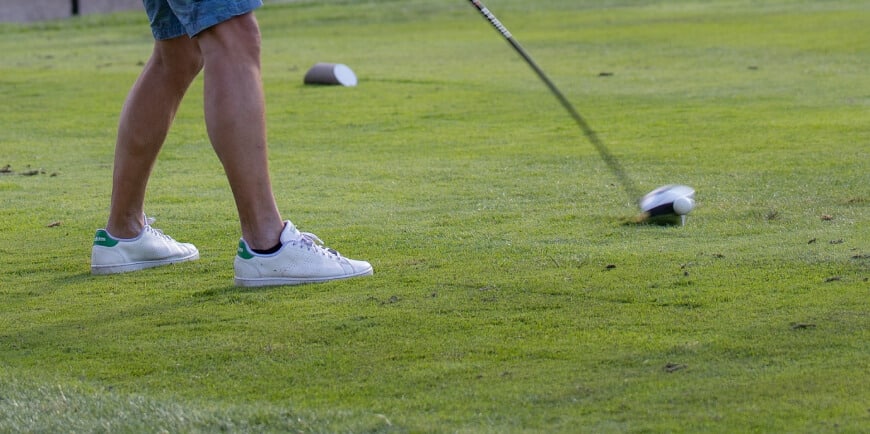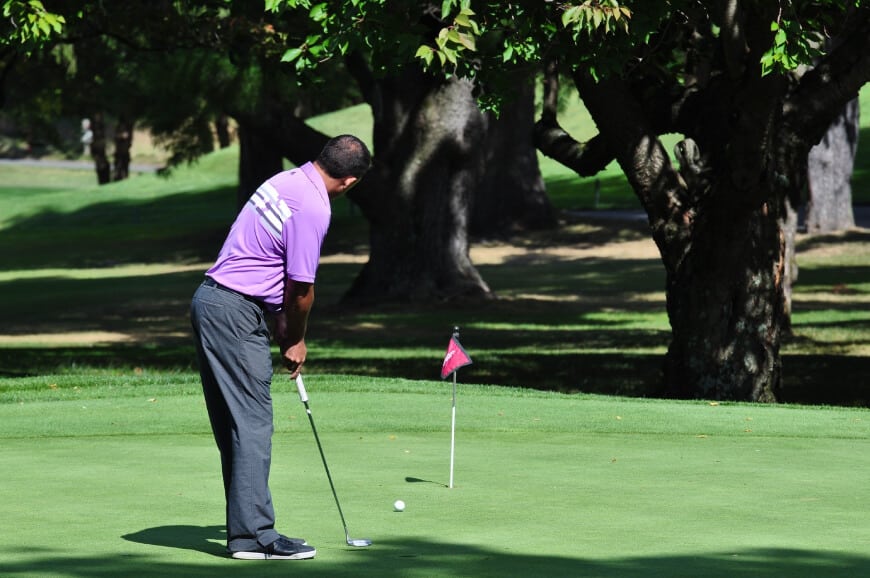They say practice makes perfect, and what better way than to do it at home! This is particularly true if you play golf, as practicing golf in your backyard means you can focus on mastering skills that matter with little to no distractions.
As a game that requires precision, it’s important to learn how every swing that you make differs from the rest. Not only that, but there’s a plethora of stuff you need to learn, and hopefully master, if you want to improve your golfing skills.
From the simple task of preparing the right golfing materials down to the very complex moves, we’re going to cover everything that you need to perfect your golf skills – all in the comfort of your own backyard.
How To Practice Golf in The Backyard?

It is great being able to practice golf in your own space. In a game where you need to constantly improve, you want to get in as many drills as possible. Here is how you can start practicing your golf at home.
Different gadgets can help you with different parts of your golfing technique. You want to get ones that effectively train your skill and target areas that need work.
1. Chipping Net
This is by far the most simple backyard practice drill to do that does not require a lot of room. Simply position the net in the center of your yard and begin chipping to it from different spots.
A chipping net’s main purpose is to train your trajectory, alignment, and spin rate to better hole your ball. Check out your cards and push yourself to improve the score every time you play.
Whether you have an acre of land or only a few square feet, you may practice those key chip shots. Those who do not have a large backyard might avoid smashing windows by using foam golf balls.
2. Floating Green
The Floating Chipping Green is a floating structure for a pool or other body of water that allows you to play golf at home. It is an excellent choice if your yard area is restricted, and it allows you to make better use of your home pool.
You can construct a DIY version of your Floating Green by connecting PVC pipes with PVC elbows. Cut a foam board to the exact form you require and attach artificial grass to the board’s surface.
This exercise improves your accuracy and distance control. Furthermore, it assists you in developing a constant rhythm to increase your ball striking, pitch angle, and spin. If you pull it too short or use too much strength, your ball will end up in the pool.
3. Golf Hitting Net
Buying a golf hitting net allows you to practice your long and mid-game from the comfort of your own home. When you consider the expense of transportation, bundles of range balls, and your commitment, they are a cost-effective option to enhance your ball striking abilities without being distracted by other golfers.
A high-quality striking net will cost roughly $400, while a good-quality mat would cost around $100. While the equipment may appear to be pricey for some people, keep in mind that you may use your practice net at any time.
Another idea is to install a ball flight monitor, which will provide you with all of the statistics and stats related to your swing. Even if you don’t, spending time hitting balls into the net will benefit your game.
4. Putting Mat
All golfers are advised to train their putting as much as possible. Luckily, putting mats allow you to improve your distance management and putting-stroke pattern.
The type and quality of the mat you select will determine its effectiveness in enhancing your putting. There are numerous mats with lines and markings to aid in alignment and tracking your ball path, allowing you to develop better consistent putting habits.
Poor-quality mats are usually poor imitations of putting greens that look nothing like the real thing. In comparison, the best putting mats will give your practice putts a realistic roll while precisely simulating the surface of a putting green.
4. Golf Simulator
Golf simulators have a plethora of technology to help you improve your game. It’s not only about hitting balls onto a screen; it’s also about learning what it takes to push your game to a higher level.
A high-quality golf simulator can provide an enjoyable escape from rainy mornings and winter weather. It will track every aspect of your swing, from your body posture to your grip to the ball contact, allowing you to enhance your consistency and skill.
These are hardly the cheapest golf equipment on the market, but their prices have fallen in recent years. Simulators, in essence, provide a platform for practicing, playing virtual games, and entertaining family members and friends.
5. Limited Flight Golf Balls
When you hit a golf ball, you may not feel it and it may appear to fly right off the club. However, if you’re practicing your shot, a heavier ball will let you feel the point of contact and focus on the spin.
Limited flight balls are often made up of two sections with very hardcovers. The balls’ hardcovers allow them to be hit repeatedly without becoming scuffed, squeezed, or destroyed.
Because they’re heavier and denser, you can tell how well you hit the ball by how hard it thuds off the club. And, because the balls aren’t flying as far, you may practice chipping even if you just have 30 feet or so to work with.
6. Orange Whip Trainer
Take out your Orange Whip trainer and start swinging through. Do this a couple of times a day and you will improve your swing plane, trajectory, and weight transfer.
The popular training tool is an orange silicone ball mounted to the end of a thick, black, bendable golf shaft with a grip on the end like something of a conventional club. Jim Hackenberg, the founder, was an aspiring professional who changed careers to become an instructor.
Because of the increased bulk in the swing stick, you must use all of your muscles to optimize your strength on the downswing. As a result, the stick improves every element of your mechanics to promote maximum distance and accuracy.
7. Clean Strike
When hitting iron shots on the golf course, you have two options: pluck the ball cleanly off the turf or swing down and take a divot.
The vast majority of golfers will prefer to hit iron shots into the ground. However, if you look at world-class golfers like Tiger Woods, you will notice that they strike the ball so precisely to give themselves a chance to get up and down for the par.
You can even do this on your home’s concrete. Take a deep breath and concentrate on capturing the ball without contacting the concrete. Even if you make a few mistakes, you will improve your ability to catch the ball cleanly.
8. Flop Shot
To perform a flop shot, make sure that you have the right lie before attempting it. The ideal lie is where a ball rests on the fairway or very light rough where it sits up but isn’t too fluffy. Then, walk up to the green to visualize your shot.
Pick your highest lofted wedge, preferably somewhere in the 58 to 62 degree range. Next, open the lob wedge’s face, aiming to the left of your target. How much you should aim left depends on how much you open the face. Make sure to avoid any forward press to set up for your flop shot.
Then, swing the club back slightly to the outside, quickly hinging your wrists. When you swing back, make sure the club face is kept open. As you finish your swing, your body should be turned toward the target, your hands finishing high and the club face still open.
9. Bunker Practice
The first thing you need to do is to take on a square and wide stance, making sure the ball is forward towards your front heel. Seeing your reflection in the club means your address position offers enough loft for you to make your shot.
Then, do a backswing over your trail shoulder. Hold that position and check if you can still see your reflection in the club face. This indicates that you were able to maintain the loft in your backswing. Finish your swing then hold your position again. You can tell that you have done the bunker shot technique correctly if you’re still able to see your reflection in the club at the top of your swing.
10. Golf Swing Tempo
Relax when taking your position. Then, find the right amount of grip pressure on the club. Control of the club must be maintained without any tension in your hands and forearms. This can differ depending on the club and the type of shot.
To set up the right tempo for your swing, you want a slow and smooth takeaway. Experiment with your swing by doing it slower than you normally do. This can help determine if your overall golf swing tempo has improved.
11. Bouncing the Golf Ball
When juggling a golf ball on your club, use your dominant hand to grip the club on the part that connects the head with the shaft. Make sure the clubface is faced skyward. Then, hold the ball a few inches over the clubface before dropping it. Try catching the ball after one hop.
Allow the ball to bounce more than once on your next try, making sure the clubface is kept directly under the ball. Slightly pulling the clubface up while the ball is falling down on it can help you maintain the bounce.
After a few bounces, move your hand to the grip end, making sure the clubface is pointed directly to the sky. Then, stop the ball on the face by angling it in such a way that reduces the bounce of the ball. Keep the clubface steady and allow the ball to settle on it.
12. The Lefty
When attempting The Lefty, make sure you have the right grip first. Your golf club should pass across your left palm, going through the base of your index finger to right above your pinkie finger. Then, adjust your stance. Ground your club behind the golf ball, placing the face of the club in a square position with the ball.
Your feet should be kept close together. Then, with your right foot, take a small step toward the right and use your left foot to take a large step to the left. This results in your feet being placed shoulder-distance apart and the ball just slightly ahead, inside your left foot’s insole.
Your swing movement must end with complete follow-through. Use all the power you can muster by swinging on the balls of your feet, coupled with a full hip rotation for the best strength and control over the shot.
13. Swing with Video
You can practice your swings alongside a tutorial video online. Figure out what type of shot you need to improve on or whether there’s a particular shot you want to try. There are also different swing drills online that you can follow and perform to improve your golf swing.
There are tutorial videos that feature a step-by-step guide to make it easy to follow along, especially for beginners. Grab your own golf club and perform these tutorials consistently and with a regular schedule until you can perfect your swings.
14. Short Game Practice Competitions
There are different short game practice competitions that all golf players can complete, regardless of if they’re a full-time player or a more casual player.
The Simple Chip Hole Out involves holing a 3 to 8-yard chip shot, on a flat green. This helps improve your accuracy and encourages commitment to chip shots.
For Par 18, select nine chips around the green. Try and chip 9 balls on then holing each putt. However, it’s far more realistic to putt each chip attempt before switching to the next location.
With the Golf Insider Short Game Challenge, you prepare eight shots around the green then from each location, hit ten balls in a row to see how many you can score.
15. The Low Point Control Drill
If you want to control the low point of your swing better, here is a drill you can do:
Take two coins and place them next to each other, one before the other. You can also choose to do it in three batches of two, with a total of six coins. Next, position your club on the back coin. The goal of the drill is to hit the front coin without jostling the coin in the back.
Once you get to the point of consistently hitting the front coin without moving the back coin, you’ll have gained incredible control of the low point in your golf swing.
16. Train for more speed in your swing
There are three exercises you can perform to increase the speed of your golf swing.
The first one is front lunges with a rotation, which can help prepare your body on creating speed from a stable platform and controlling the proper body rotation in the swing. The second one is rotational squat, which trains the right sequence of your swing as well as using the ground and lower body for leverage. Finally, pelvic rotations help train the proper sequencing and movement of the lower body, letting it function independently of the upper body.
Using a lighter shaft also helps improve the speed of your swing without sacrificing accuracy. But make sure to not go too light as this can decrease the speed instead. Find the right balance of weight and flex for your club.
17. Work on your mechanics
If you want to develop a more accurate and dependable golf swing, then knowledge of the mechanics involved and proper application is needed.
Positioning yourself properly is one such mechanic. Another one is how you swing the club in a way that makes it effortless. The backswing is also a crucial part of your golf swing. When completing your backswing, a slight delay should be observed before proceeding to the downswing. The downswing itself should start slow and progressively build until maximum velocity is reached at impact.
How to Practice Golf with a Net in the Backyard?
Whether you’re practicing your short game or longer shots, using a net is good for setting a target for you to aim at for your swings. You want to be as precise as possible, and you do not want to lose your golf balls.
You can get a variety of different golf nets in the market for the kind of practice you will need. It could be a chipping net or a golf-hitting net – that’s totally up to you!
Here’s how you can set up your backyard golf practice with a net:
1. Find Enough Space
It doesn’t matter if you are practicing a long shot or a short one. You want to get as much space as you can for your swings and the distance that the ball is going to travel. You also want to ensure that you won’t be hitting other things while practicing just in case you can’t get it into the net yet.
2. Set Up your Net
There are different kinds of net setups. There are ones that have a collapsible frame, and there are also ones that you need to hang yourself. You want to set up your net at a good distance away from you so you can properly hit the ball and aim at the target.
3. Practice
To practice the accuracy that you need for playing golf, ensure that you are hitting the targets on the net. If your net doesn’t have targets, then you can make one yourself or just make sure the ball makes it into the net. Accuracy is affected by swing speed and other factors, so you need to focus on practicing those as well.
How to Practice Chipping in the Backyard?

A chip is a golf shot that spends little time in the air. It is shot low, basically just letting the ball roll from where you hit it to the target. Since it is the most important shot to lower your number of swings, here are some drills you can practice to perfect it:
1. Chip Across Yard
Place your golf balls in a line and chip them one at a time. Make sure you set a target so you can practice the strength you need to hit it as well as your accuracy.
2. Coin Chipping Drill
This exercise helps you have cleaner contact with the ball and make chipping it easier. It is also simple to set up. Just put some coins on the ground and start hitting them.
FAQ’s
You can get some gadgets to help you get your practice in, but they are not necessary. You can still practice your golfing skills without them. Just find a space in your backyard or inside your home where you can comfortably swing your club and get the ball moving.
Whether you are a beginner who doesn’t own your clubs yet or just don’t want to get them out you, you can work on your swings without needing your clubs. Practice your form and your stance, then imagine how you are going to hit the ball.
Yes! They can help with your accuracy and consistency in striking the ball.
Conclusion
As you can see, you can certainly learn how to practice golf in the backyard. You just need the right golfing equipment and learn the right techniques to improve your golfing skills at home.
Matt Stevens is the founder of Golfrough.com. He holds a Postgraduate in Sports Marketing and has played golf since he was four years old. Having experienced every high and low golf has to offer, his writing helps the average golfer avoid the mistakes he has made in 28-years on the course.

